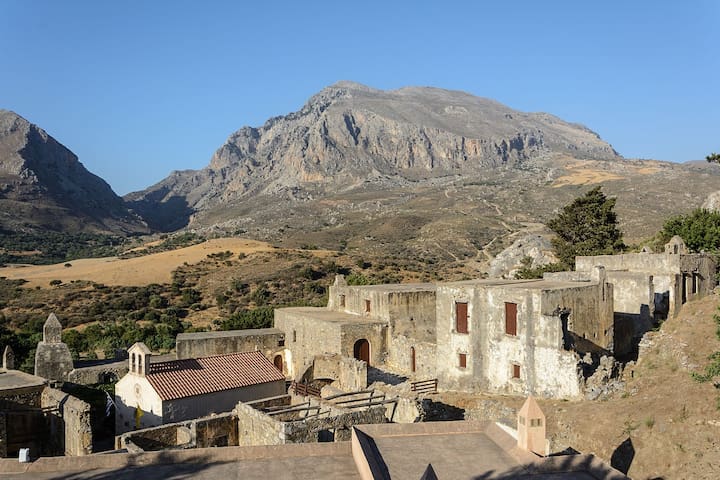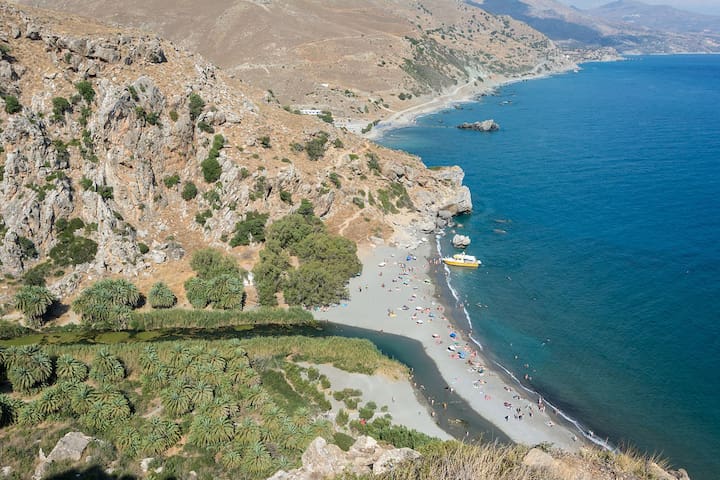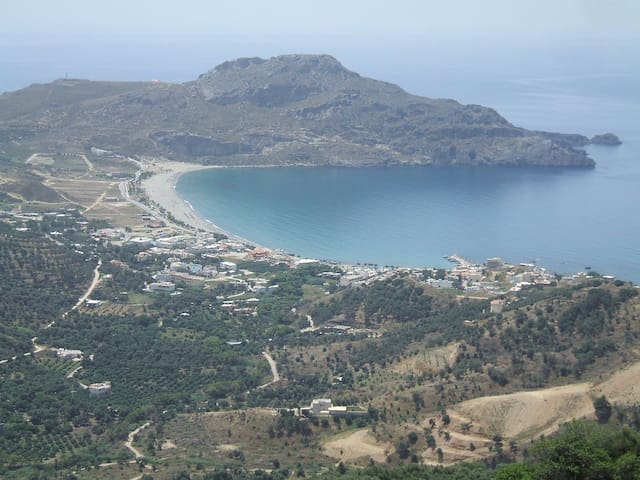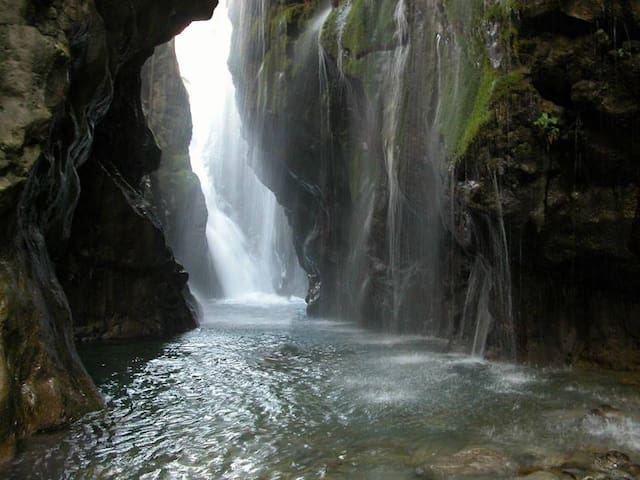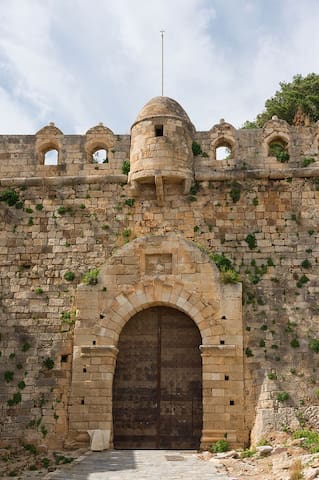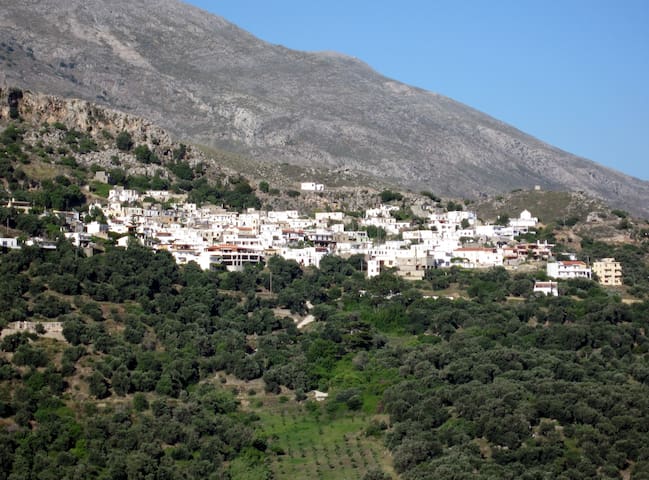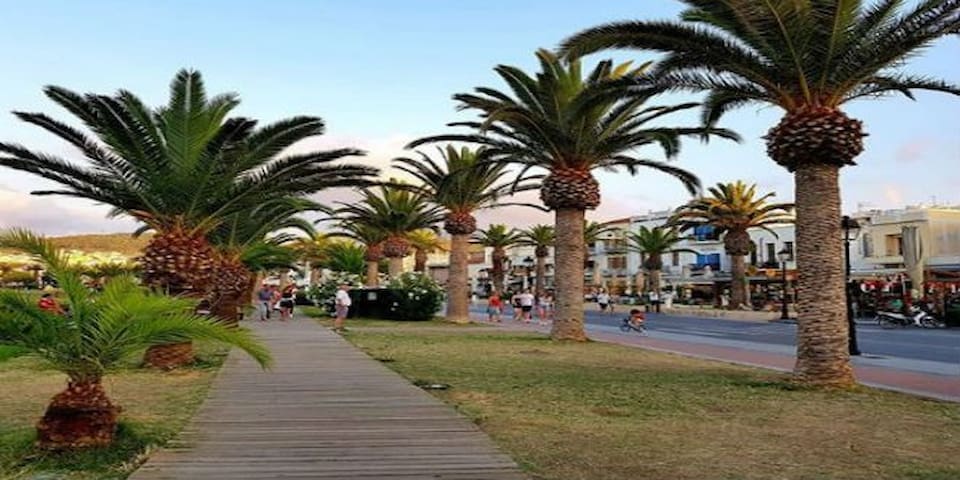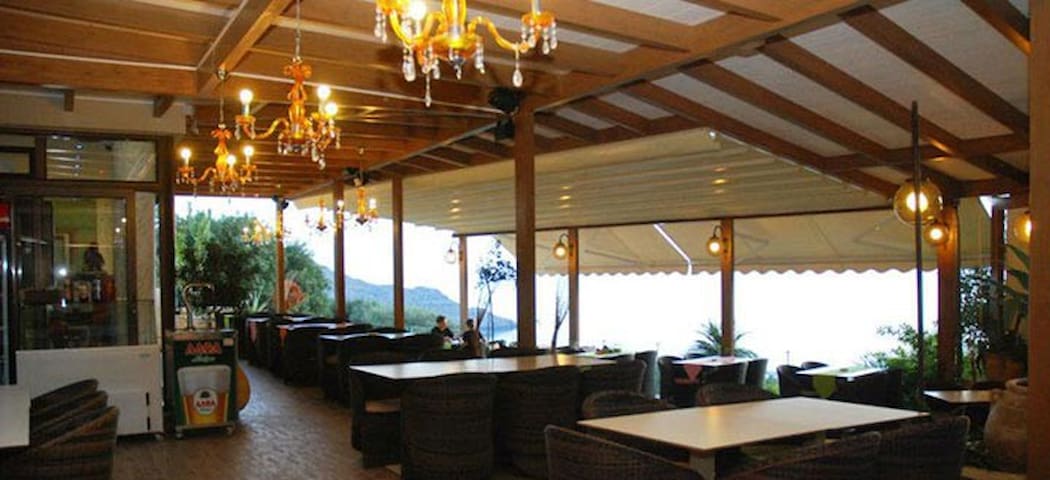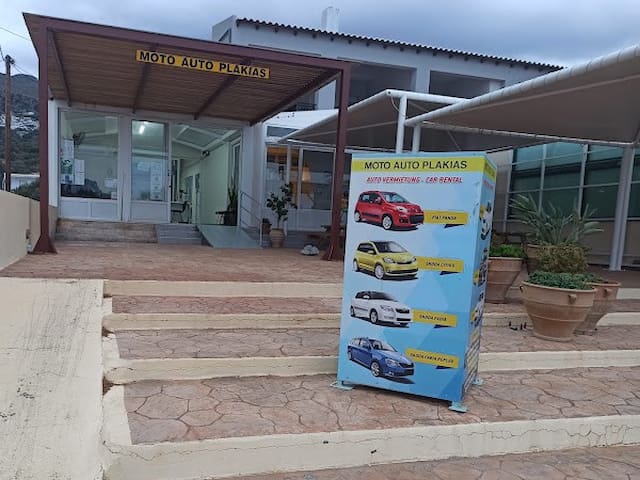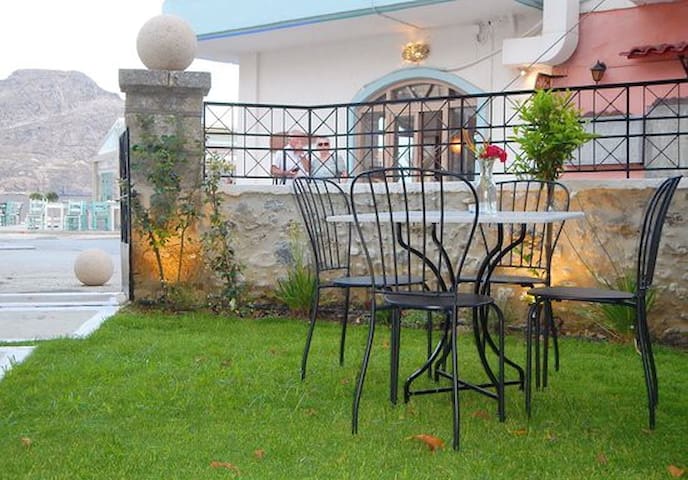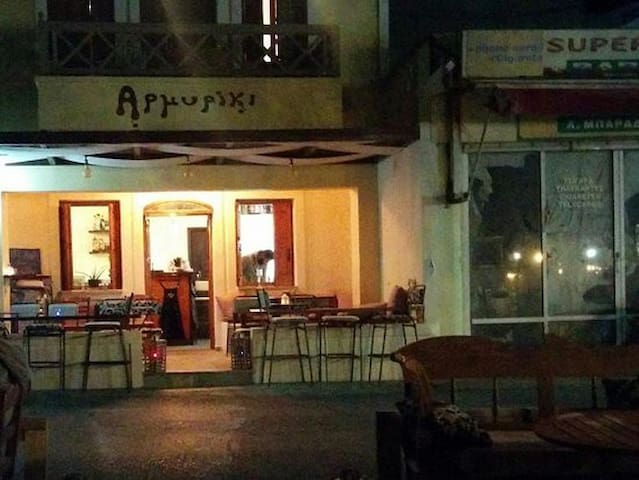Worthwhile Sights
The Holy Stavropegiac[1] and Patriarchal Preveli Monastery of St. John the Theologian, known as the Monastery of Preveli, comprises two main building complexes, the ruined Lower Monastery of St. John the Baptist, and the currently operational Upper (Rear) Monastery of St. John the Theologian.
The monastery was probably founded in the Middle Ages, during the occupation of Crete by the Republic of Venice, its founder being a feudal lord named Prevelis. It developed over several centuries as a religious and cultural centre for the local population. After the Ottoman Turkish occupation of the island, Abbot Melchissedek Tsouderos led a group of rebels in the Greek War of Independence in 1821, one result of which was that the monastery was destroyed, but later rebuilt. In 1866 and 1878, the monastery was again active in organising rebellions against the Turks, which helped contribute to Crete's eventual independence and then its political union with Greece.
In the Battle of Crete in 1941, Agathangelos Lagouvardos helped supply British, Australian and New Zealand troops on the island, and provided shelter for them. A group of Australian soldiers protected by the monastery managed to secure their rescue by submarine from the island at Preveli Beach. After this was discovered, the Lower Monastery was destroyed by German forces.
The upper monastery contains numerous religious relics and icons, and many of its buildings, now heavily restored, are open to the public. There are also a number of monuments to the work of the monastery during the Second World War, many of them financed by rescued Australian former soldiers. Among the Allied soldiers to receive shelter and assistance from the monastery of Preveli during WWII was Australian Corporal Geoff Edwards. In commemoration, he settled the seaside hamlet of Margaret River in Western Australia calling it Prevelly.[2] A small producer of premium wines from the Margaret River region also bears the name Preveli.
99 Recomendado por los habitantes de la zona
Preveli Monastery
The Holy Stavropegiac[1] and Patriarchal Preveli Monastery of St. John the Theologian, known as the Monastery of Preveli, comprises two main building complexes, the ruined Lower Monastery of St. John the Baptist, and the currently operational Upper (Rear) Monastery of St. John the Theologian.
The monastery was probably founded in the Middle Ages, during the occupation of Crete by the Republic of Venice, its founder being a feudal lord named Prevelis. It developed over several centuries as a religious and cultural centre for the local population. After the Ottoman Turkish occupation of the island, Abbot Melchissedek Tsouderos led a group of rebels in the Greek War of Independence in 1821, one result of which was that the monastery was destroyed, but later rebuilt. In 1866 and 1878, the monastery was again active in organising rebellions against the Turks, which helped contribute to Crete's eventual independence and then its political union with Greece.
In the Battle of Crete in 1941, Agathangelos Lagouvardos helped supply British, Australian and New Zealand troops on the island, and provided shelter for them. A group of Australian soldiers protected by the monastery managed to secure their rescue by submarine from the island at Preveli Beach. After this was discovered, the Lower Monastery was destroyed by German forces.
The upper monastery contains numerous religious relics and icons, and many of its buildings, now heavily restored, are open to the public. There are also a number of monuments to the work of the monastery during the Second World War, many of them financed by rescued Australian former soldiers. Among the Allied soldiers to receive shelter and assistance from the monastery of Preveli during WWII was Australian Corporal Geoff Edwards. In commemoration, he settled the seaside hamlet of Margaret River in Western Australia calling it Prevelly.[2] A small producer of premium wines from the Margaret River region also bears the name Preveli.
Preveli beach and lagoon (Greek Λίμνη του Πρέβελη), sometimes known locally as "Palm Beach", is located below the monastery, at the mouth of the Kourtaliótiko gorge. Behind the beach is an extensive glade of palm trees. According to a local legend, the King of Ithaca, Odysseus, remained in the wider area of Lake Preveli after the end of the Trojan War, on his return to Ithaca from Troy. The area is a popular tourist destination due to the river, the forest with the palm trees in the gorge and the sandy beach with the clear waters. In the beach, there is a rock in the shape of a heart "The stone of lovers" according to the locals. The beach is regularly served by tourist boats from the nearby resort of Plakias. On August 22, 2010, a large proportion of the palm grove was destroyed in a fire but by 2011 had totally and rapidly naturally re-generated. There are many positive signs that P. Theophrasti not only is able generally to re-generate successfully but the oldest and youngest palms of this palm forest, too, were totally re-generated by the summer of 2011.
Preveli Beach station
Preveli beach and lagoon (Greek Λίμνη του Πρέβελη), sometimes known locally as "Palm Beach", is located below the monastery, at the mouth of the Kourtaliótiko gorge. Behind the beach is an extensive glade of palm trees. According to a local legend, the King of Ithaca, Odysseus, remained in the wider area of Lake Preveli after the end of the Trojan War, on his return to Ithaca from Troy. The area is a popular tourist destination due to the river, the forest with the palm trees in the gorge and the sandy beach with the clear waters. In the beach, there is a rock in the shape of a heart "The stone of lovers" according to the locals. The beach is regularly served by tourist boats from the nearby resort of Plakias. On August 22, 2010, a large proportion of the palm grove was destroyed in a fire but by 2011 had totally and rapidly naturally re-generated. There are many positive signs that P. Theophrasti not only is able generally to re-generate successfully but the oldest and youngest palms of this palm forest, too, were totally re-generated by the summer of 2011.
Plakias is a village on the south coast of the Greek island of Crete, in the Rethymno regional unit, about 21 kilometres south of the city of Rethymno. It is part of the municipality Agios Vasileios, and of the municipal unit Foinikas. It is surrounded by mountains to the north and the Libyan Sea to the south. The name in Greek means "flat", because the town stands on an alluvial fan of material that has washed down the Kotsifou gorge directly to the north . This material has formed along the sea's edge into a long, fine, gold-hued sand beach, which shelves very gradually out into the bay, making it quite safe for swimming and hence, for family holidays.
Initially just a fishing jetty and a few houses, Plakias developed during the last few decades into a tourist resort. The first official mention of Plakias was in 1961, when it was recorded in a census as the permanent home of six fishermen. The recorded history of surrounding mountain villages like Myrthios and Sellia goes back to the 10th century, when the Byzantine Emperor Nikephoros II Phokas (961 AD) built roads and bridges in order to link those villages, and there are some fragments of wall remaining from a fortified area on a hill top just northeast of the present main town. The local area is geographically suitable for a settlement, having plenty of agricultural space, and there may well have been a settlement there since Minoan times.
Plakias has a 1300-metre-long sandy beach and there are several other beaches within walking distance (Souda, Damnoni, Ammoudi, and Schinaria). The southeastern end of the beach, near the Kakomouri headland, is used by nudists. The town is not on any major passage for traffic and hence traffic is minimal and it is quieter and less dusty than many other Greek resorts.
Parking along the main town road is difficult in the high season, but there is a large free-parking area just east of the main town. There are plenty of places to eat along the sea front, with the biggest cluster of tavernas at the west end. 8 kilometers to the east is the historic monastery of Preveli, which may have been founded as early as the 10th century. Due to its isolated position, it has played an important role in Cretan revolts against occupying forces such as the Nazis in World War II. Near the monastery and in a short distance from Plakias is the Preveli Beach. This is a very beautiful spot, where there is a forest with palm trees, in a gorge with a river and a beautiful beach. The area is accessible from the port of Plakias.
Plakias is home to the "Youth Hostel Plakias", set in olive groves behind the town, which is famous among international backpackers as the 'most southerly hostel' in Europe. Also well-known are the cafes "Nufaro", (known locally as "Joe's bar") and the bars "Ostraco" and "Cozy Backyard". "World International Tourism Day" is celebrated each September with a big evening festival, with a free buffet meal and free traditional music, songs, and dancing performances in the main square.
There are two roads leading to Plakias through the mountain range that lies to the north, both of which run through spectacular gorges—to the north of Plakias, the Kotsifos Gorge, and to the northeast, the Kourtaliotiko Gorge. A good coastal motor track runs west beyond Souda to Rodakino beach, Frangokastello and Sfakiá. There are plenty of walks locally, and bolder walkers will enjoy the high green countryside beyond the coastal mountain range north of town. Mountain biking and cycle touring are other local attractions.
There are several buses daily to and from Rethymnon bus station; some of these go via Preveli Monastery. The Plakias bus stop is on the seafront taxi rank .
108 Recomendado por los habitantes de la zona
Plakias
Plakias is a village on the south coast of the Greek island of Crete, in the Rethymno regional unit, about 21 kilometres south of the city of Rethymno. It is part of the municipality Agios Vasileios, and of the municipal unit Foinikas. It is surrounded by mountains to the north and the Libyan Sea to the south. The name in Greek means "flat", because the town stands on an alluvial fan of material that has washed down the Kotsifou gorge directly to the north . This material has formed along the sea's edge into a long, fine, gold-hued sand beach, which shelves very gradually out into the bay, making it quite safe for swimming and hence, for family holidays.
Initially just a fishing jetty and a few houses, Plakias developed during the last few decades into a tourist resort. The first official mention of Plakias was in 1961, when it was recorded in a census as the permanent home of six fishermen. The recorded history of surrounding mountain villages like Myrthios and Sellia goes back to the 10th century, when the Byzantine Emperor Nikephoros II Phokas (961 AD) built roads and bridges in order to link those villages, and there are some fragments of wall remaining from a fortified area on a hill top just northeast of the present main town. The local area is geographically suitable for a settlement, having plenty of agricultural space, and there may well have been a settlement there since Minoan times.
Plakias has a 1300-metre-long sandy beach and there are several other beaches within walking distance (Souda, Damnoni, Ammoudi, and Schinaria). The southeastern end of the beach, near the Kakomouri headland, is used by nudists. The town is not on any major passage for traffic and hence traffic is minimal and it is quieter and less dusty than many other Greek resorts.
Parking along the main town road is difficult in the high season, but there is a large free-parking area just east of the main town. There are plenty of places to eat along the sea front, with the biggest cluster of tavernas at the west end. 8 kilometers to the east is the historic monastery of Preveli, which may have been founded as early as the 10th century. Due to its isolated position, it has played an important role in Cretan revolts against occupying forces such as the Nazis in World War II. Near the monastery and in a short distance from Plakias is the Preveli Beach. This is a very beautiful spot, where there is a forest with palm trees, in a gorge with a river and a beautiful beach. The area is accessible from the port of Plakias.
Plakias is home to the "Youth Hostel Plakias", set in olive groves behind the town, which is famous among international backpackers as the 'most southerly hostel' in Europe. Also well-known are the cafes "Nufaro", (known locally as "Joe's bar") and the bars "Ostraco" and "Cozy Backyard". "World International Tourism Day" is celebrated each September with a big evening festival, with a free buffet meal and free traditional music, songs, and dancing performances in the main square.
There are two roads leading to Plakias through the mountain range that lies to the north, both of which run through spectacular gorges—to the north of Plakias, the Kotsifos Gorge, and to the northeast, the Kourtaliotiko Gorge. A good coastal motor track runs west beyond Souda to Rodakino beach, Frangokastello and Sfakiá. There are plenty of walks locally, and bolder walkers will enjoy the high green countryside beyond the coastal mountain range north of town. Mountain biking and cycle touring are other local attractions.
There are several buses daily to and from Rethymnon bus station; some of these go via Preveli Monastery. The Plakias bus stop is on the seafront taxi rank .
The Kourtaliotiko Gorge, also known as the Asomatos Gorge (Greek: Φαράγγι Ασώματου), is a gorge on the southern side of the western part of the island of Crete. It is situated where the Kourtaliotiko River flows southwards between the mountains of Kouroupa and Xiron.
The village of Koxare is at the northern end of the gorge. A road runs north to south through the gorge connecting Koxare to Asomatos; it then leads west, to the town of Plakias on the southern coast of Crete.
There is a small church (Agios Nikolaos) in the gorge and a 40-metre-high waterfall.
The cliffs on the side of the gorge provide a roosting site for the Lammergeier vulture.[1]
There is a specific point on the gorge, about 20 metres from the northern entrance, some "claps" can be heard, like hands coming together. These "claps" are the "kourtala", that give the name ο Κουρταλιώτης ( o Kourtaliotis , "the rattle" and "the noisy") to the gorge. These are a consequence of the wind being funnelled through the high caves of the gorge and breaking the sound barrier. The point near the northern entrance is the main point where this sound can be heard.
The gorge leads to a sandy beach Preveli, and is inhabited by native palm trees.[2] An experienced hiker could follow the path across the river in order to reach the beach. It takes about 2 and a half hours at an average pace. However, there is an alternative path, one parallel to the river, which easier and faster to walk through.
92 Recomendado por los habitantes de la zona
Kourtaliotiko Gorge
The Kourtaliotiko Gorge, also known as the Asomatos Gorge (Greek: Φαράγγι Ασώματου), is a gorge on the southern side of the western part of the island of Crete. It is situated where the Kourtaliotiko River flows southwards between the mountains of Kouroupa and Xiron.
The village of Koxare is at the northern end of the gorge. A road runs north to south through the gorge connecting Koxare to Asomatos; it then leads west, to the town of Plakias on the southern coast of Crete.
There is a small church (Agios Nikolaos) in the gorge and a 40-metre-high waterfall.
The cliffs on the side of the gorge provide a roosting site for the Lammergeier vulture.[1]
There is a specific point on the gorge, about 20 metres from the northern entrance, some "claps" can be heard, like hands coming together. These "claps" are the "kourtala", that give the name ο Κουρταλιώτης ( o Kourtaliotis , "the rattle" and "the noisy") to the gorge. These are a consequence of the wind being funnelled through the high caves of the gorge and breaking the sound barrier. The point near the northern entrance is the main point where this sound can be heard.
The gorge leads to a sandy beach Preveli, and is inhabited by native palm trees.[2] An experienced hiker could follow the path across the river in order to reach the beach. It takes about 2 and a half hours at an average pace. However, there is an alternative path, one parallel to the river, which easier and faster to walk through.
The Fortezza is the citadel of the city of Rethymno in Crete, Greece. It was built by the Venetians in the 16th century, and was captured by the Ottomans in 1646. By the early 20th century, many houses were built within the citadel. These were demolished after World War II, leaving only a few historic buildings within the Fortezza. Today, the citadel is in good condition and is open to the public.
The Fortezza is built on a hill called Paleokastro (meaning "Old Castle"), which was the site of ancient Rhithymna's acropolis. Between the 10th and 13th centuries, the Byzantines established a fortified settlement to the east of the hill. It was called Castrum Rethemi, and it had square towers and two gates. The fortifications were repaired by Enrico Pescatore in the beginning of the 13th century. After Crete fell to the Republic of Venice, the settlement became known as the Castel Vecchio or Antico Castello, which both mean "old castle."
Under Venetian rule, a small harbour was built in Rethymno, which became the third most important city on Crete after Heraklion and Chania. On 8 April 1540, a line of fortifications began to be built around the city. The walls were designed by the architect Michele Sanmicheli, and were completed in around 1570. These fortifications were not strong enough to withstand a large assault, and when Uluç Ali Reis attacked in 1571, the Ottomans captured and sacked the city.
541 Recomendado por los habitantes de la zona
Castillo de Fortezza
The Fortezza is the citadel of the city of Rethymno in Crete, Greece. It was built by the Venetians in the 16th century, and was captured by the Ottomans in 1646. By the early 20th century, many houses were built within the citadel. These were demolished after World War II, leaving only a few historic buildings within the Fortezza. Today, the citadel is in good condition and is open to the public.
The Fortezza is built on a hill called Paleokastro (meaning "Old Castle"), which was the site of ancient Rhithymna's acropolis. Between the 10th and 13th centuries, the Byzantines established a fortified settlement to the east of the hill. It was called Castrum Rethemi, and it had square towers and two gates. The fortifications were repaired by Enrico Pescatore in the beginning of the 13th century. After Crete fell to the Republic of Venice, the settlement became known as the Castel Vecchio or Antico Castello, which both mean "old castle."
Under Venetian rule, a small harbour was built in Rethymno, which became the third most important city on Crete after Heraklion and Chania. On 8 April 1540, a line of fortifications began to be built around the city. The walls were designed by the architect Michele Sanmicheli, and were completed in around 1570. These fortifications were not strong enough to withstand a large assault, and when Uluç Ali Reis attacked in 1571, the Ottomans captured and sacked the city.
The village of Myrthios is located approximately 30 km far from the city of Rethymno and overlooks the cove of Plakias of the prefecture of Rethymno.
At the foot of Mount Vrisinas the green village of Myrthios stands, whose name according to tradition originates in the word myrtiá (=myrtle), since once in the center of the village there was a large myrtle tree.
The residents of Myrthios village do not all hail from Crete, as many moved here from different parts of Greece, while the village was also inhabited by pirates in the past.
The first written record of the village Myrthios is found in the Venetian era, as a fief of a Venetian family. It is said that initially the village was built near the sea, but the frequent pirate raids forced the inhabitants to move to higher grounds.
Today, close to Myrthios village at the beach of Paligremnos, there are some small caves, which were used as a refuge during the German occupation. Moreover, in this area, when it is a full moon and especially since the beginning of September until the end of January, the moon is reflected in the sea and big squids go out on the sand.
In Myrthios, there is the church of the Transfiguration of the Savior, which was built before 961 and the church of Agios Charalambos with a Venetian bell of 1589. The Kotsifou gorge passes by the village, while in the mountains of a wider area there are ruins of towers.
Myrthios
The village of Myrthios is located approximately 30 km far from the city of Rethymno and overlooks the cove of Plakias of the prefecture of Rethymno.
At the foot of Mount Vrisinas the green village of Myrthios stands, whose name according to tradition originates in the word myrtiá (=myrtle), since once in the center of the village there was a large myrtle tree.
The residents of Myrthios village do not all hail from Crete, as many moved here from different parts of Greece, while the village was also inhabited by pirates in the past.
The first written record of the village Myrthios is found in the Venetian era, as a fief of a Venetian family. It is said that initially the village was built near the sea, but the frequent pirate raids forced the inhabitants to move to higher grounds.
Today, close to Myrthios village at the beach of Paligremnos, there are some small caves, which were used as a refuge during the German occupation. Moreover, in this area, when it is a full moon and especially since the beginning of September until the end of January, the moon is reflected in the sea and big squids go out on the sand.
In Myrthios, there is the church of the Transfiguration of the Savior, which was built before 961 and the church of Agios Charalambos with a Venetian bell of 1589. The Kotsifou gorge passes by the village, while in the mountains of a wider area there are ruins of towers.
Nearby Beaches
One of the most beautiful beaches on the island of Crete is Damnoni Beach, located in an idyllic bay just a few kilometers from the more famous resort of Plakias and about 35 km south of the city of Rethymno, on the southern coast of the island. Backed by the mountains and closed in by splendid rock formations, with white sand and turquoise waters, the beach of Damnoni and the several smaller beaches that can be found nearby are truly astonishing.
102 Recomendado por los habitantes de la zona
Damoni Beach
One of the most beautiful beaches on the island of Crete is Damnoni Beach, located in an idyllic bay just a few kilometers from the more famous resort of Plakias and about 35 km south of the city of Rethymno, on the southern coast of the island. Backed by the mountains and closed in by splendid rock formations, with white sand and turquoise waters, the beach of Damnoni and the several smaller beaches that can be found nearby are truly astonishing.
Kalypso Beach Crete is one of the best beaches in Crete, and one of the most unusual. It’s set in its own secret cove a short drive from the beach village of Plakias Crete. It’s also part of the Kalypso Cretan Village Resort & Spa, one of several Plakias resorts close by.
It’s very different to most Crete beaches because of its incredible setting. It’s a long, narrow sea inlet between a soaring sea cliff on one side and a narrow finger of land on the other. There’s no sand, just rock and water.
A bridge links both sides of the inlet – called the ‘Pirate’s Fjord’. This is possibly unique among Greece beaches – you come here to swim, snorkel or soak in the sun from the rocky area above the water.
16 Recomendado por los habitantes de la zona
Kalypso Beach
Kalypso Beach Crete is one of the best beaches in Crete, and one of the most unusual. It’s set in its own secret cove a short drive from the beach village of Plakias Crete. It’s also part of the Kalypso Cretan Village Resort & Spa, one of several Plakias resorts close by.
It’s very different to most Crete beaches because of its incredible setting. It’s a long, narrow sea inlet between a soaring sea cliff on one side and a narrow finger of land on the other. There’s no sand, just rock and water.
A bridge links both sides of the inlet – called the ‘Pirate’s Fjord’. This is possibly unique among Greece beaches – you come here to swim, snorkel or soak in the sun from the rocky area above the water.
Ammoudi beach it is a stunning remote beach with fine golden sand, which is formed in a small cove, that is not easily seen from the road. The beach is totally secluded and is ideal for families. The locals know this place and come daily with their families. The beach is surrounded by high cliffs and smooth white rocks, reminding of marbles, but the seabed is sandy.
500 m southwest from the main Ammoudi beach, there is a smaller but quieter beach, with the name Mikro (small) Ammoudi. It is not visible from the main beach or the asphalt road, but if one wants to walk and enjoy nature by walking a little over the hills, he will see a picturesque and beautiful beach a little further west. You will need a 10-minute walk to get there without a problem because there is a distinct dirt road and footpaths that you can take. The length of the beach is not over 70m.
19 Recomendado por los habitantes de la zona
Ammoudi Beach
Ammoudi beach it is a stunning remote beach with fine golden sand, which is formed in a small cove, that is not easily seen from the road. The beach is totally secluded and is ideal for families. The locals know this place and come daily with their families. The beach is surrounded by high cliffs and smooth white rocks, reminding of marbles, but the seabed is sandy.
500 m southwest from the main Ammoudi beach, there is a smaller but quieter beach, with the name Mikro (small) Ammoudi. It is not visible from the main beach or the asphalt road, but if one wants to walk and enjoy nature by walking a little over the hills, he will see a picturesque and beautiful beach a little further west. You will need a 10-minute walk to get there without a problem because there is a distinct dirt road and footpaths that you can take. The length of the beach is not over 70m.
The eastern part of the long beach is called Paligremnos. The beach is sandy and very well organized, next to hotels and restaurants. Characteristic of Paligremnos are nearby vertical cliffs that rise to a great height that attract many climbers. This place is called Gonates (i.e. knees), because according to tradition, the epic hero Digenis kneeled there to drink water from a local spring. In Paligremnos a strange phenomenon takes place on every full moon, from September to January. The moonlight is reflected in the mirror-like towering cliffs. Thus, many big squids approach the beach and locals gather them with big sticks. Lastly, some meters to the south of Paligremnos there are some tunnels, carved for transfering coal to cargo ships in the past.
6 Recomendado por los habitantes de la zona
Plakias Beach (Paralia Paligremnos)
The eastern part of the long beach is called Paligremnos. The beach is sandy and very well organized, next to hotels and restaurants. Characteristic of Paligremnos are nearby vertical cliffs that rise to a great height that attract many climbers. This place is called Gonates (i.e. knees), because according to tradition, the epic hero Digenis kneeled there to drink water from a local spring. In Paligremnos a strange phenomenon takes place on every full moon, from September to January. The moonlight is reflected in the mirror-like towering cliffs. Thus, many big squids approach the beach and locals gather them with big sticks. Lastly, some meters to the south of Paligremnos there are some tunnels, carved for transfering coal to cargo ships in the past.
Small "secret" beach, not organized but quiet and usually with no wind when Plakias is windy also without sun in the afternoon
Foteinari beach
Small "secret" beach, not organized but quiet and usually with no wind when Plakias is windy also without sun in the afternoon
City/town information
Rethymno (also Rethimno, Rethymnon, Réthymnon, and Rhíthymnos) is a city in Greece on the island of Crete. It is the capital of Rethymno regional unit, and has a population of more than 30,000 inhabitants (near 40,000 for the municipal unit). It is a former Latin Catholic bishopric as Retimo(–Ario) and former Latin titular see.
Rethymno was originally built during the Minoan civilization (ancient Rhithymna and Arsinoe). The city was prominent enough to mint its own coins and maintain urban growth. One of these coins is today depicted as the crest of the town: two dolphins in a circle.
This region as a whole is rich with ancient history, most notably through the Minoan civilisation centred at Knossos east of Rethymno.[2] Rethymno itself began a period of growth when the Venetian conquerors of the island decided to put an intermediate commercial station between Heraklion and Chania, acquiring its own bishop and nobility in the process. Today's old town (palia poli) was almost entirely built by the Republic of Venice. It is one of the best-preserved old towns in Crete.
From circa 1250 the city was the seat of the Latin Diocese of Retimo, which was renamed Retimo–Ario after the absorption in 1551 of the Diocese of Ario and as suppressed only after the Turkish conquest.
The town still maintains its old aristocratic appearance, with its buildings dating from the 16th century, arched doorways, stone staircases, Byzantine and Hellenic-Roman remains, the small Venetian harbour and narrow streets. The Venetian Loggia houses the information office of the Ministry of Culture and Sports. A Wine Festival is held there annually at the beginning of July. Another festival, in memory of the destruction of the Arkadi Monastery, is held on 7–8 November.
The city's Venetian-era citadel, the Fortezza of Rethymno, is one of the best-preserved castles in Crete. Other monuments include the Neratze mosque (the Municipal Odeon arts centre), the Great Gate (Μεγάλη Πόρτα or "Porta Guora"), the Piazza Rimondi and the Loggia.
The town was captured by the Ottoman Empire in 1646 during the Cretan War (1645–69) and they ruled it for almost three centuries. The town, called Resmo in Turkish, was the centre of a sanjak (administrative part of a province) during Ottoman rule.
During the Battle of Crete (20–30 May 1941), the Battle of Rethymno was fought between German paratroopers and the Second Australian Imperial Force and Hellenic Army. Although initially unsuccessful, the Germans won the battle after receiving reinforcements from Maleme in the Northwestern part of the island.
Today the city's main income is from tourism, many new facilities having been built in the past 20 years. Agriculture is also notable, especially for olive oil and other Mediterranean products.
Municipality
24 Recomendado por los habitantes de la zona
Rethymno
Rethymno (also Rethimno, Rethymnon, Réthymnon, and Rhíthymnos) is a city in Greece on the island of Crete. It is the capital of Rethymno regional unit, and has a population of more than 30,000 inhabitants (near 40,000 for the municipal unit). It is a former Latin Catholic bishopric as Retimo(–Ario) and former Latin titular see.
Rethymno was originally built during the Minoan civilization (ancient Rhithymna and Arsinoe). The city was prominent enough to mint its own coins and maintain urban growth. One of these coins is today depicted as the crest of the town: two dolphins in a circle.
This region as a whole is rich with ancient history, most notably through the Minoan civilisation centred at Knossos east of Rethymno.[2] Rethymno itself began a period of growth when the Venetian conquerors of the island decided to put an intermediate commercial station between Heraklion and Chania, acquiring its own bishop and nobility in the process. Today's old town (palia poli) was almost entirely built by the Republic of Venice. It is one of the best-preserved old towns in Crete.
From circa 1250 the city was the seat of the Latin Diocese of Retimo, which was renamed Retimo–Ario after the absorption in 1551 of the Diocese of Ario and as suppressed only after the Turkish conquest.
The town still maintains its old aristocratic appearance, with its buildings dating from the 16th century, arched doorways, stone staircases, Byzantine and Hellenic-Roman remains, the small Venetian harbour and narrow streets. The Venetian Loggia houses the information office of the Ministry of Culture and Sports. A Wine Festival is held there annually at the beginning of July. Another festival, in memory of the destruction of the Arkadi Monastery, is held on 7–8 November.
The city's Venetian-era citadel, the Fortezza of Rethymno, is one of the best-preserved castles in Crete. Other monuments include the Neratze mosque (the Municipal Odeon arts centre), the Great Gate (Μεγάλη Πόρτα or "Porta Guora"), the Piazza Rimondi and the Loggia.
The town was captured by the Ottoman Empire in 1646 during the Cretan War (1645–69) and they ruled it for almost three centuries. The town, called Resmo in Turkish, was the centre of a sanjak (administrative part of a province) during Ottoman rule.
During the Battle of Crete (20–30 May 1941), the Battle of Rethymno was fought between German paratroopers and the Second Australian Imperial Force and Hellenic Army. Although initially unsuccessful, the Germans won the battle after receiving reinforcements from Maleme in the Northwestern part of the island.
Today the city's main income is from tourism, many new facilities having been built in the past 20 years. Agriculture is also notable, especially for olive oil and other Mediterranean products.
Municipality
Worth to visit Food places
Plateia Taverna, Mirthios.
Plateia Taverna is the oldest in Mirthios, on the South coast of Crete. It offers some of the best food of the island along with a breath-taking view over the ocean to go with it. The famous home-cooked food in Plateia Taverna is served up in generous portions by an efficient and friendly team headed by the owner Frederikos Kalogerakis. If you can’t decide what you want to eat — a common problem in this delicious tavern — it’s possible to make your own finger food or meze platter from a selection on the menu!
18 Recomendado por los habitantes de la zona
Plateia Tavern
8 Epar.Od. Dichalostratou-LeukogiasPlateia Taverna, Mirthios.
Plateia Taverna is the oldest in Mirthios, on the South coast of Crete. It offers some of the best food of the island along with a breath-taking view over the ocean to go with it. The famous home-cooked food in Plateia Taverna is served up in generous portions by an efficient and friendly team headed by the owner Frederikos Kalogerakis. If you can’t decide what you want to eat — a common problem in this delicious tavern — it’s possible to make your own finger food or meze platter from a selection on the menu!
The tavern is located in Mirthios village just a few kilometres away from Plakias right on the side of the mountain between the two gorges of Kotsifou and Kourtaliotis. The panoramic view of the Plakias bay, the Lybian sea,the surrounding area is one of our advantages.
You'll find us at the entrance of the village on the main road.
The family and friendly environment combined with the primed cuisine and unparalleled view are the reasons that our customers applaud us by coming back every year. By our place you will enjoy your meal under the colors of the sunset. The place, which was recently renovated, is characterized by the warm atmosphere, the cleanliness and comfort.
6 Recomendado por los habitantes de la zona
Taverna Dionyssos
The tavern is located in Mirthios village just a few kilometres away from Plakias right on the side of the mountain between the two gorges of Kotsifou and Kourtaliotis. The panoramic view of the Plakias bay, the Lybian sea,the surrounding area is one of our advantages.
You'll find us at the entrance of the village on the main road.
The family and friendly environment combined with the primed cuisine and unparalleled view are the reasons that our customers applaud us by coming back every year. By our place you will enjoy your meal under the colors of the sunset. The place, which was recently renovated, is characterized by the warm atmosphere, the cleanliness and comfort.
Restaurant Vrisi, Mirthios.
Nice restaurant hidden in the hills of Mirthios. The restaurant has a very nice modern Greek atmosphere. Relaxing and open! Good seats with big pillows. This makes Vrisi outstanding of the other restaurants in Myrthios and I guess of the restaurants in Plakias area as well. The view of Plakias and the Libyan sea is very nice. But keep in mind that all the restaurants and hotels in Myrthios have this view. Myrthios is an ideal place to visit and the other two restaurants well worth a visit. The service is like it should be. Very good and welcoming but with a good appropriate distance. Not all dishes are great but in general the food is good. Would surely recommend this restaurant as the view and food is far better than an average Greek restaurant.
11 Recomendado por los habitantes de la zona
Restaurant Vrisi
Restaurant Vrisi, Mirthios.
Nice restaurant hidden in the hills of Mirthios. The restaurant has a very nice modern Greek atmosphere. Relaxing and open! Good seats with big pillows. This makes Vrisi outstanding of the other restaurants in Myrthios and I guess of the restaurants in Plakias area as well. The view of Plakias and the Libyan sea is very nice. But keep in mind that all the restaurants and hotels in Myrthios have this view. Myrthios is an ideal place to visit and the other two restaurants well worth a visit. The service is like it should be. Very good and welcoming but with a good appropriate distance. Not all dishes are great but in general the food is good. Would surely recommend this restaurant as the view and food is far better than an average Greek restaurant.
Really great taverna in Plakias. I was thrilled by the incredible sea view. It has traditional dishes to try. The food is like mummy's . In addition to the classic Greek taverna dishes, you will find dishes of the day taken from the tradition of the Cretan hinterland, delicious and good price / quality ratio. Very nice panoramic view towards Plakias beach
11 Recomendado por los habitantes de la zona
Merastri Taverna
Really great taverna in Plakias. I was thrilled by the incredible sea view. It has traditional dishes to try. The food is like mummy's . In addition to the classic Greek taverna dishes, you will find dishes of the day taken from the tradition of the Cretan hinterland, delicious and good price / quality ratio. Very nice panoramic view towards Plakias beach
GioMa Taverna located in Plakias.
Greek cuisine under the direction of the talented chef is wonderful at this place. Spend a nice time here and share perfectly cooked grilled squid, grilled swordfish and grilled salads with your friends. Visit this restaurant to try good baklava, ice cream and parfait.
The staff is said to be competent here. Service at this place is something one can call cool. From the guests' viewpoint, prices are average. It's usually good to experience something new and enjoy the charming atmosphere.
12 Recomendado por los habitantes de la zona
GioMa Taverna
GioMa Taverna located in Plakias.
Greek cuisine under the direction of the talented chef is wonderful at this place. Spend a nice time here and share perfectly cooked grilled squid, grilled swordfish and grilled salads with your friends. Visit this restaurant to try good baklava, ice cream and parfait.
The staff is said to be competent here. Service at this place is something one can call cool. From the guests' viewpoint, prices are average. It's usually good to experience something new and enjoy the charming atmosphere.
Medousa Restaurant in Plakias.
Visit this place and enjoy Greek cuisine. This restaurant serves tasty tuna, fillet steaks and Greek salads. Many guests say that waiters serve good panna cotta and tasty food here. Delicious house wine, rakia or beer will make your meal tastier and you'll surely come back. It's nice to taste great coffee.
Medousa Restaurant
Agiou GeorgiouMedousa Restaurant in Plakias.
Visit this place and enjoy Greek cuisine. This restaurant serves tasty tuna, fillet steaks and Greek salads. Many guests say that waiters serve good panna cotta and tasty food here. Delicious house wine, rakia or beer will make your meal tastier and you'll surely come back. It's nice to taste great coffee.
Antoni's Place in Plakias.
The menu of this restaurant is recommended to Greek and Mediterranean cuisine lovers. Serving nicely cooked grilled squid, octopus and fish is the feature of Antonis Place. Most guests recommend trying good food. This place is known for delicious raki or good wine.
Antoni's Place
Antoni's Place in Plakias.
The menu of this restaurant is recommended to Greek and Mediterranean cuisine lovers. Serving nicely cooked grilled squid, octopus and fish is the feature of Antonis Place. Most guests recommend trying good food. This place is known for delicious raki or good wine.
Tasomanolis in Plakias.
Greek and Mediterranean cuisines are well-cooked at this restaurant. It's time to relax and order nicely cooked calamari, salmon and op la. Here you will be offered tasty pannacotta and baklava. Most likely, you'll return to Tasomanolis later to taste good house wine, raki or white wine.
Tasomanolis
Tasomanolis in Plakias.
Greek and Mediterranean cuisines are well-cooked at this restaurant. It's time to relax and order nicely cooked calamari, salmon and op la. Here you will be offered tasty pannacotta and baklava. Most likely, you'll return to Tasomanolis later to taste good house wine, raki or white wine.
Minoiko Tavernaki in Plakias.
If you appreciate Greek and Mediterranean cuisines, come to this restaurant. Order nicely cooked salads, mushrooms and briam. Delicious wine, beer or raki are waiting for you at Minoiko.
It is remarkable that the service is noted as terrific.
Μινωικό Ταβερνάκι
Minoiko Tavernaki in Plakias.
If you appreciate Greek and Mediterranean cuisines, come to this restaurant. Order nicely cooked salads, mushrooms and briam. Delicious wine, beer or raki are waiting for you at Minoiko.
It is remarkable that the service is noted as terrific.
Essentials
In Plakias Shopping Center you will find anything you might need. Super Market, grocery store, take away coffee, hair salon, book store - post office, department store
Plakias shopping center ( SYNKA )
In Plakias Shopping Center you will find anything you might need. Super Market, grocery store, take away coffee, hair salon, book store - post office, department store
Very good pharmacy in Plakias, well stocked and very friendly staff.
Several pharmacies can be found in Plakias. Opening hours for pharmacies are from 08:00 to 14.00 and from 17:30 to 20:30 hours, Monday to Friday, except from public holidays. Also, some pharmacies are open during the weekend. When closed, details of a 24 hour duty chemist are usually displayed on the shop’s door. Pharmacists are usually very good at giving advice for non-urgent problems and you may not need a prescription for certain medicines.
Kartsonakis Maτth
Very good pharmacy in Plakias, well stocked and very friendly staff.
Several pharmacies can be found in Plakias. Opening hours for pharmacies are from 08:00 to 14.00 and from 17:30 to 20:30 hours, Monday to Friday, except from public holidays. Also, some pharmacies are open during the weekend. When closed, details of a 24 hour duty chemist are usually displayed on the shop’s door. Pharmacists are usually very good at giving advice for non-urgent problems and you may not need a prescription for certain medicines.
Very good pharmacy in Plakias, well stocked and very friendly staff.
Several pharmacies can be found in Plakias. Opening hours for pharmacies are from 08:00 to 14.00 and from 17:30 to 20:30 hours, Monday to Friday, except from public holidays. Also, some pharmacies are open during the weekend. When closed, details of a 24 hour duty chemist are usually displayed on the shop’s door. Pharmacists are usually very good at giving advice for non-urgent problems and you may not need a prescription for certain medicines.
11 Recomendado por los habitantes de la zona
Pharmacy Goumenaki Konstadina
Very good pharmacy in Plakias, well stocked and very friendly staff.
Several pharmacies can be found in Plakias. Opening hours for pharmacies are from 08:00 to 14.00 and from 17:30 to 20:30 hours, Monday to Friday, except from public holidays. Also, some pharmacies are open during the weekend. When closed, details of a 24 hour duty chemist are usually displayed on the shop’s door. Pharmacists are usually very good at giving advice for non-urgent problems and you may not need a prescription for certain medicines.
In Spili you will find a Health Center, in case you need a general doctor. In case you need an ambulance please call 166.
11 Recomendado por los habitantes de la zona
Κέντρο Υγείας Σπηλίου
ΔΗΜΟΣ ΑΓIn Spili you will find a Health Center, in case you need a general doctor. In case you need an ambulance please call 166.
General Doctor service.
Plakias medical care is located at: Megalou Alexandrou, 740 60 Plakias.
Opening hours
Monday: 09:00 - 13:30
Tuesday: 09:00 - 13:30
Wednesday: 09:00 - 13:30
Thursday: 09:00 - 13:30
Friday: 09:00 - 13:30
Saturday: 09:00 - 13:30
Sunday: -
Plakias Medical Care, Dr E. Alexandrakis M.D., M.Sc.
DimokratiasGeneral Doctor service.
Plakias medical care is located at: Megalou Alexandrou, 740 60 Plakias.
Opening hours
Monday: 09:00 - 13:30
Tuesday: 09:00 - 13:30
Wednesday: 09:00 - 13:30
Thursday: 09:00 - 13:30
Friday: 09:00 - 13:30
Saturday: 09:00 - 13:30
Sunday: -
Car and Bike Rental
Most experienced rental company in Plakias, est. 1986! We value your personal care, fair prices and reliable service. Request a quote & book your car directly
Moto Auto Plakias S.A.
Most experienced rental company in Plakias, est. 1986! We value your personal care, fair prices and reliable service. Request a quote & book your car directly
Very good service, kind staff and reasonable prices! Definitely one of the best choice for a rental car in Plakias
Car Island Plakias
Megalou AlexandrouVery good service, kind staff and reasonable prices! Definitely one of the best choice for a rental car in Plakias
Coffee - cocktails - beers - breakfast - brunch
Α peaceful oasis with nice music, providing excellent coffee, interesting and tasty cocktails and beers. Also breakfast, brunch, light bites.
L'Etoile du sud
Α peaceful oasis with nice music, providing excellent coffee, interesting and tasty cocktails and beers. Also breakfast, brunch, light bites.
One of the best places in Plakias! Incredible view, music and of course amazing cocktails! It's worth going to have a drink, relax and look at the sea!
Armyriki
One of the best places in Plakias! Incredible view, music and of course amazing cocktails! It's worth going to have a drink, relax and look at the sea!

